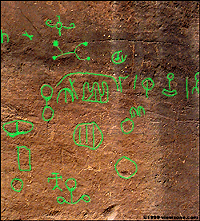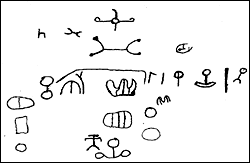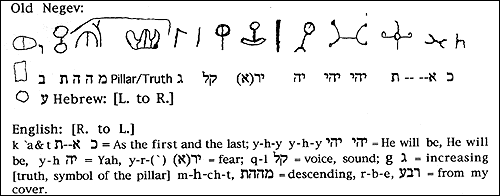 Of the hundreds of panels located at this particular site, south of La Junta, Colorado, most were grouped in long, horizontal rows. Some of these rows extended almost 60 feet. Photographing a panel of this size was not anticipated at the time of Viewzone's 1998 Expedition, led by Gary Vey; however, thanks to the Polaroid Corporation, we have been given a hi-resolution camera which has enabled permanent digital records of this site to be made. We located three medium resolution photographs that were taken in the 1998 Expedition and were able to combine these digital images to illustrate a panel that is almost 6 meters square. This panel is shown on the right.
Of the hundreds of panels located at this particular site, south of La Junta, Colorado, most were grouped in long, horizontal rows. Some of these rows extended almost 60 feet. Photographing a panel of this size was not anticipated at the time of Viewzone's 1998 Expedition, led by Gary Vey; however, thanks to the Polaroid Corporation, we have been given a hi-resolution camera which has enabled permanent digital records of this site to be made. We located three medium resolution photographs that were taken in the 1998 Expedition and were able to combine these digital images to illustrate a panel that is almost 6 meters square. This panel is shown on the right.
The canyon itself is the perfect place to use flooding techniques for farming and there is ample evidence of many thriving communities along the sunny side of the canyon walls. There is evidence of canopy construction from the pairs of holes in the canyon's western face. These would have supported wooden poles which would then become the supports for a roof. [In the linked photograph you can see the holes (white arrows) - and also a "Yah" symbol, presumably placed over the roof line as a sign of respect - and a curious petroglyph of a crib? (red arrows)].
The panel (right) shows some excellent examples of the Old Negev script and is almost free from the Plains Indian carvings that often make translations so difficult to read. [If you wish to see a larger, more detailed digital image of this panel, click on the animation.]
This panel illustrates several "ligatures" which combine the basic alphabetical symbols. It also includes the utilization of "ideograms" such as "the pillar of truth" which denotes that the phrase is an important one whose validity and certainty are not to be doubted.
 Once the collection of symbols is copied, the flow and direction of the translation must be determined. In this panel the symbols begin in the upper left and move down. Then, the symbols are read from right to left, following the horizontal pattern, then they continue from top to bottom. An understanding of old Hebrew and a familiarity with Old Negev are assets that Dr. Harris, who translated this panel, has acquired in his years of studying such petroglyphs in the Sinai, Utah and Nevada. His initial translations are often right on target. On certain panels, he attempts to translate in different directions to see if the results vary or are still linguistically patent. It not uncommon to find a series of letters that reads from both directions and each meaning compliments the other. As Vey states, "This is one way that this ancient language of 22 symbols and of words no longer than three characters could be so specific in meaning. Ligatures are another such tool, allowing the arrangement of symbols to be both 'read' in the traditional sense, and also 'recognized' by their configuration."
Once the collection of symbols is copied, the flow and direction of the translation must be determined. In this panel the symbols begin in the upper left and move down. Then, the symbols are read from right to left, following the horizontal pattern, then they continue from top to bottom. An understanding of old Hebrew and a familiarity with Old Negev are assets that Dr. Harris, who translated this panel, has acquired in his years of studying such petroglyphs in the Sinai, Utah and Nevada. His initial translations are often right on target. On certain panels, he attempts to translate in different directions to see if the results vary or are still linguistically patent. It not uncommon to find a series of letters that reads from both directions and each meaning compliments the other. As Vey states, "This is one way that this ancient language of 22 symbols and of words no longer than three characters could be so specific in meaning. Ligatures are another such tool, allowing the arrangement of symbols to be both 'read' in the traditional sense, and also 'recognized' by their configuration."
The panel above was successfully organized as seen below:

As the First and the Last, He will be, He will be, Yah.
Fear the sound of increasing truth (pillar of truth) descending from my cover (hiding place).
Obviously, as with all of the translations, the context of the phrases cannot be known and so the exact meaning of the words is lost to time. This could have been a prayer or a song or an idiom expression.
Consider some of our common expressions like, "The grass is always greener..." or "A stitch in time saves nine..." These phrases could pose similar problems to future scholars of our language if they were to be interpreted literally. Perhaps "increasing truth descending from my cover (hiding place)" is another way of asking for blessings to be bestowed on one's home.
In any case, this translation, and the several examples that follow, demonstrate the ability to give meaning to the Colorado petroglyphs and show a cultural link between these authors and their ancestors who lived in the middle east some 3500 years ago.
|